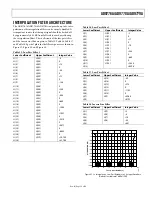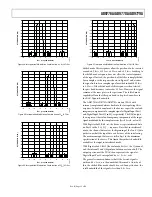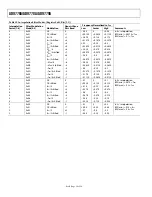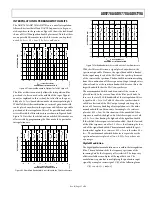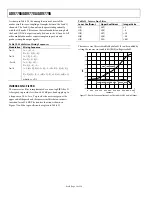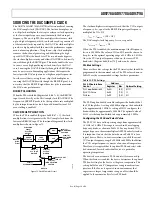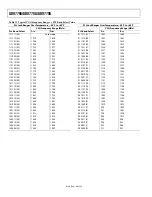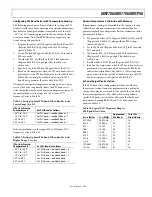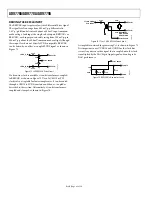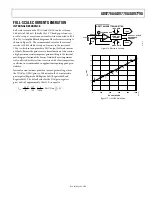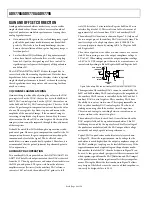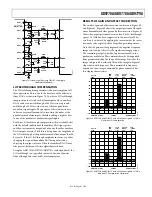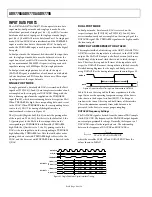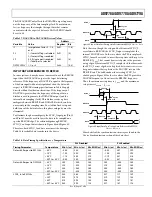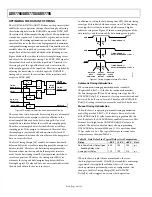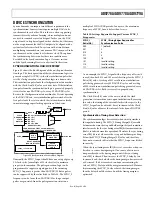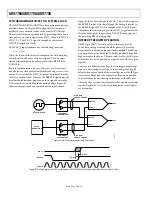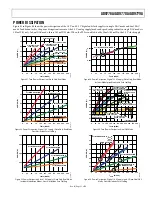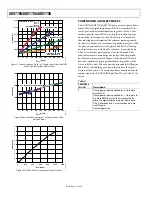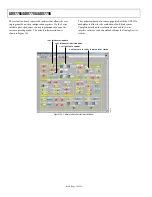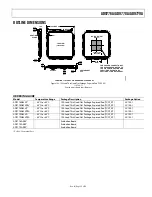
AD9776A/AD9778A/AD9779A
Rev. B | Page 47 of 56
The DATACLKDIV only affects the DATACLK output frequency,
not the frequency of the data sampling clock. To maintain an
f
DATACLK
frequency that samples the input data that remains
consistent with the expected data rate, DATACLKDIV should
be set to 00.
Table 27. DACCLK to DATACLK Divisor Values
Variable Value
Address
Register Bit
IF
Interpolation factor (1, 2, 4,
or 8)
0x01 [7:6]
ZS
1, if zero stuffing is disabled
2, if zero stuffing is enabled
0x01 [0]
SP
0.5, if single port is enabled
1, if dual port is selected
0x02 [6]
DATACLKDIV
1, 2, or 4
0x03
[5:4]
INPUT DATA REFERENCED TO REFCLK
In some systems, it may be more convenient to use the REFCLK
input than the DATACLK output as the input data timing
reference. If the frequency of DACCLK is equal to the frequency
of the data input (without interpolation), then the data with
respect to REFCLK± timing specifications in Table 28 apply
directly without further considerations. If the frequency of
DACCLK is greater than the frequency of the input data, a
divider is used to generate the DATACLK output (and the
internal data sampling clock). This divider creates a phase
ambiguity between REFCLK and DATACLK, which results in
uncertainty in the sampling time. To establish fixed setup and
hold times of the data interface, this phase ambiguity must be
eliminated.
To eliminate the phase ambiguity, the SYNC_I input pins (Pin 13
and Pin 14) must be used to force the data to be sampled on a
specific REFCLK edge. The relationship among REFCLK,
SYNC_I, and input data is shown in Figure 84 and Figure 85.
Therefore, both SYNC_I and data must meet the timing in
Table 28 for reliable data transfer into the device.
06
452
-30
9
t
SREFCLK
t
HREFCLK
t
S_SYNC
t
H_SYNC
SYNC_I
REFCLK
DATA
Figure 84. Input Data Port Timing, Data Referenced to REFCLK, f
DACCLK
= f
REFCLK
Note that even though the setup and hold times of SYNC_I
are relative to REFCLK, the SYNC_I input is sampled at the
internal DACCLK rate. In the case where the PLL is employed,
SYNC_I must be asserted to meet the setup time with respect to
REFCLK (t
S_SYNC
), but cannot be asserted prior to the previous
rising edge of the internal SYNC_I sample clock. In other words,
the SYNC_I assert edge has to be placed between its successive
keep out windows that replicate at the DACCLK rate, not the
REFCLK rate. The valid window for asserting SYNC_I is
shaded gray in Figure 85 for the case where the PLL provides a
DACCLK frequency of four times the REFCLK frequency.
Thus, the minimum setup time is t
S_SYNC
, and the maximum
setup time is t
DACCLK
− t
H_SYNC
.
t
SREFCLK
t
DACCLK
t
H_SYNC
t
S_SYNC
t
HREFCLK
06
45
2-
31
0
DACCLK
DATA
SYNC_I
REFCLK
Figure 85. Input Data Port Timing, Data Referenced to REFCLK,
f
DACCLK
= f
REFCLK
× 4
More details of the synchronization circuitry are found in the
Device Synchronization section of this data sheet.
Table 28. Data Timing Specifications vs. Temperature
Timing Parameter
Temperature
PLL Disabled
PLL Enabled
Min t
S
(ns)
Min t
H
(ns)
Min KOW (ns)
Min t
S
(ns)
Min t
H
(ns)
Min KOW (ns)
Data with Respect to REFCLK±
−40°C
−0.80
3.35
2.55
−0.83
3.87
2.99
+25°C −1.00
3.50
2.50 −1.06
4.04
2.98
+85°C −1.10
3.80
2.70 −1.19
4.37
3.16
−40°C to +85°C
−0.80
3.80
3.00
−0.83
4.37
3.54
Data with Respect to DATACLK
−40°C
2.50
−0.05
2.45
2.50
−0.05
2.45
+25°C 2.70 −0.20
2.50
2.70 −0.20
2.50
+85°C 3.00 −0.40
2.60
3.00 −0.40
2.60
−40°C
to
+85°C
3.00 −0.05
2.95
3.00 −0.05
2.95
SYNC_I± to REFCLK±
−40°C
0.30
0.65
0.95
0.27
1.17
1.39
+25°C 0.25
0.75
1.00 0.19
1.29
1.48
+85°C 0.15
0.90
1.05 0.06
1.47
1.51
−40°C to +85°C
0.30
0.90
1.20
0.27
1.47
1.74

